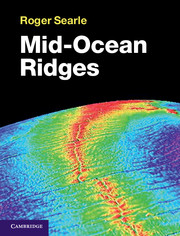Book contents
- Frontmatter
- Dedication
- Contents
- Preface
- 1 Introduction
- 2 Techniques of MOR study: a brief historical review
- 3 The oceanic lithosphere
- 4 Ridges as plate boundaries
- 5 Crustal structure and composition
- 6 Volcanism
- 7 Tectonism
- 8 Hydrothermal processes
- 9 Summary and synthesis
- Appendix A Glossary of terms
- Appendix B Directory of named features
- References
- Index
- Plate Section
5 - Crustal structure and composition
Published online by Cambridge University Press: 05 June 2014
- Frontmatter
- Dedication
- Contents
- Preface
- 1 Introduction
- 2 Techniques of MOR study: a brief historical review
- 3 The oceanic lithosphere
- 4 Ridges as plate boundaries
- 5 Crustal structure and composition
- 6 Volcanism
- 7 Tectonism
- 8 Hydrothermal processes
- 9 Summary and synthesis
- Appendix A Glossary of terms
- Appendix B Directory of named features
- References
- Index
- Plate Section
Summary
Introduction
The oceanic lithosphere is a mechanical boundary layer, defined by its rigid, elastic properties and distinguished from the underlying asthenosphere, which has a plastic rheology (Chapter 3). On the other hand, the crust reflects the chemical differentiation of the Earth, and comprises rocks that are generally less dense and have lower seismic velocities than the underlying mantle. The oceanic crust is up to about 7 km thick. It consists mainly of products formed by partial melting of the mantle: basaltic lavas and the gabbros and dolerites that form their deep-seated counterparts, with similar chemistry but larger mineral grains resulting from slower cooling and crystallisation. Our knowledge of the structure of oceanic crust comes mainly from a combination of seismological, gravity and sampling studies (Cann, 1970, 1974; Carbotte and Scheirer, 2004).
Crustal thickness
The Mohorovičić discontinuity, or Moho for short, marks the base of the crust. It was originally defined seismically (on continents) as a velocity discontinuity at which the P-wave velocity first exceeds 8.0 km s-1; sometimes this is called the ‘seismological Moho’. In contrast, the ‘petrological’ Moho is defined as the base of the geological crust, irrespective of seismic velocity (Section 5.3.4). The earliest oceanic seismic refraction experiments detected the seismological Moho at depths of some 6 – 8 km below the base of the sediments – much less than the thickness of the continental crust (Raitt, 1956; Hill, 1957; Raitt, 1963; Figure 2.12).
- Type
- Chapter
- Information
- Mid-Ocean Ridges , pp. 92 - 128Publisher: Cambridge University PressPrint publication year: 2013



